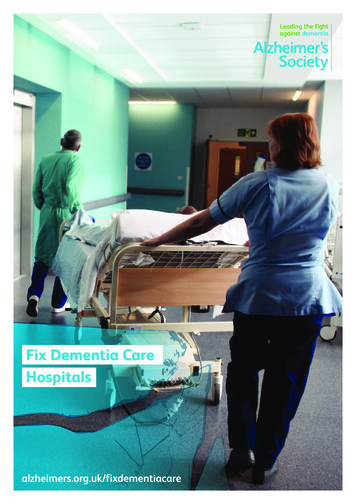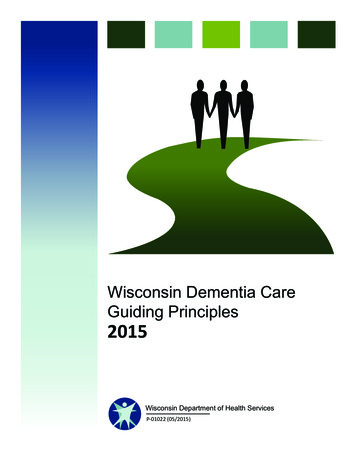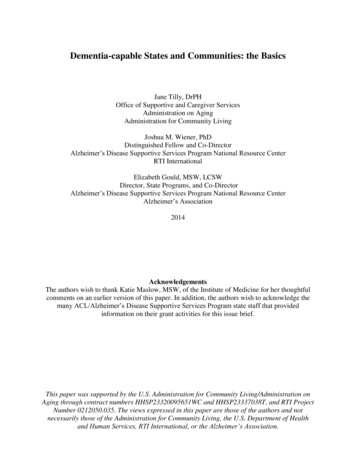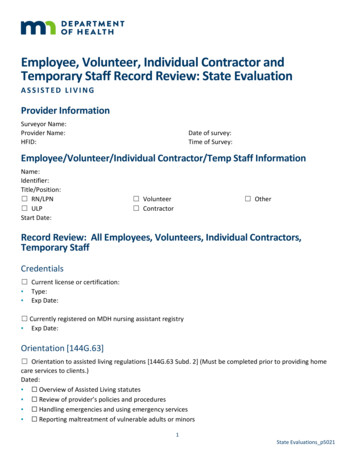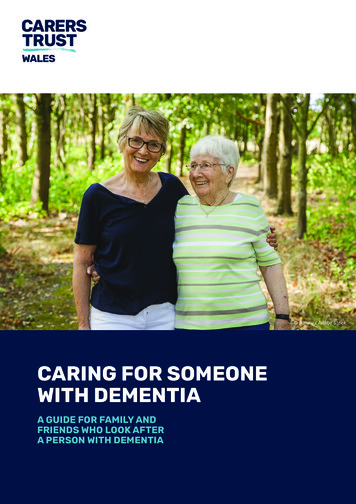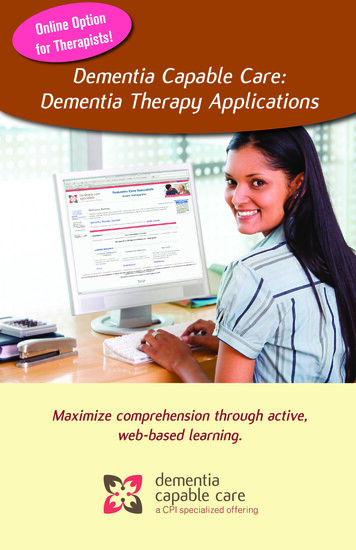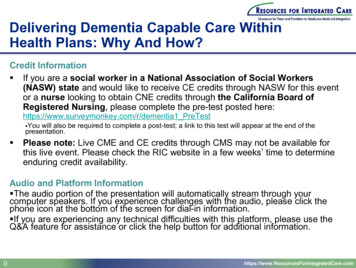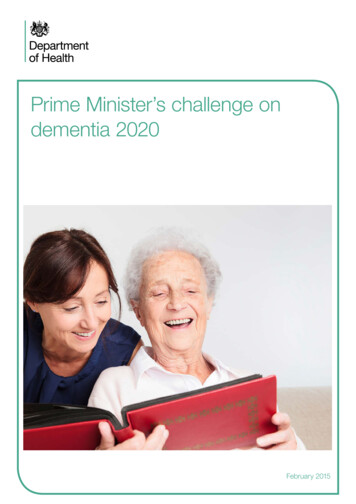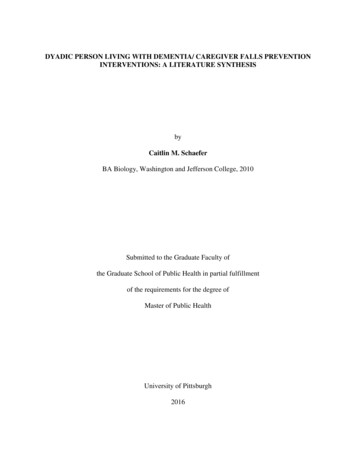
Transcription
DYADIC PERSON LIVING WITH DEMENTIA/ CAREGIVER FALLS PREVENTIONINTERVENTIONS: A LITERATURE SYNTHESISbyCaitlin M. SchaeferBA Biology, Washington and Jefferson College, 2010Submitted to the Graduate Faculty ofthe Graduate School of Public Health in partial fulfillmentof the requirements for the degree ofMaster of Public HealthUniversity of Pittsburgh2016
UNIVERSITY OF PITTSBURGHGRADUATE SCHOOL OF PUBLIC HEALTHThis thesis was presentedbyCaitlin M. SchaeferIt was defended onNovember 22, 2016and approved byThesis Advisor:Steven Albert, PhDProfessor and ChairDepartment of Behavioral and Community Health SciencesGraduate School of Public HealthUniversity of PittsburghCommittee Member:Jeanette Trauth, PhDAssociate ProfessorDepartment of Behavioral and Community Health SciencesGraduate School of Public HealthUniversity of PittsburghCommittee Member:Jennifer Lingler, PhD, CRNPAssociate ProfessorHealth and Community SystemsSchool of NursingUniversity of Pittsburghii
Copyright by Caitlin M. Schaefer2016iii
DYADIC PERSON LIVING WITH DEMENTIA/ CAREGIVER/ FALLSPREVENTION INTERVENTIONS: A LITERATURE SYNTHESISCaitlin M. SchaeferUniversity of Pittsburgh, 2016ABSTRACTPeople living with dementia experience falls at a disproportionate rate than age-matchedadults due to several factors: gait dysfunction, balance disorders, and modifiable externalhazards. Currently, falls prevention interventions conducted in this population have hadinconclusive results because falls prevention interventions tailored for cognitively normal adultsdo not translate to those living with dementia, thus leaving a gap in knowledge in this field ofresearch.Caregivers of people living with dementia may provide a unique aspect to fallsprevention interventions as they are in a position to act as co-therapists throughout the course ofan intervention. By utilizing caregivers as co-therapists in a dyadic intervention, interventionistsare able to rely on them to aid the person living with dementia in the execution of theintervention and to confirm that the person living with dementia is following protocol, which hasbeen shown to be vital in program success in past interventions.In addition to exploring the relationship between caregiver involvement and outcomes offalls prevention interventions in the dementia population, this literature synthesis will alsoevaluate the effectiveness of a falls prevention program among people with dementia accordingto whether people live alone or with family as a proxy for caregiver involvement in fallsprevention that has been conducted in Pennsylvania recently.iv
Dyadic falls prevention in the dementia population is an area of research that requiresfurther exploration. This area of research is significant to public health because public health’sability to impact society by decreasing hospitalizations and delaying institutionalizations byproviding additional years of improved quality of life in the dementia population can savebillions of dollars in healthcare costs.v
TABLE OF CONTENTSPREFACE . IX1.0INTRODUCTION . 12.0METHODS . 33.0LITERATURE SYNTHESIS . 73.1FALLS IN THE ELDERLY . 83.2FALLS IN PEOPLE LIVING WITH DEMENTIA (PLWD) . 93.2.1Risk factors for falls in the dementia population . 103.2.2Falls prevention in PLWD. 133.2.3Dyadic falls prevention interventions. 173.3FALLS AND THE CAREGIVER . 193.4DYADIC INTERVENTIONS TO SUPPORT PHYSICAL HEALTH . 204.0HEALTHY STEPS FOR OLDER ADULTS. 285.0DISCUSSION . 316.05.1LIMITATIONS OF THIS REVIEW . 335.2FUTURE DIRECTIONS. 33CONCLUSIONS . 35APPENDIX: PUBMED SEARCH QUERIES. 36BIBLIOGRAPHY . 41vi
LIST OF TABLESTable 1. Dyadic falls prevention intervention summaries . 18Table 2. Dyadic interventions to support physical health summaries . 26vii
LIST OF FIGURESFigure 1. PubMed search words. 4Figure 2. Healthy Steps for Older Adults participants. 29viii
PREFACEI would like to thank Dr. Steven Albert for all of his patience and guidance throughout thisprocess and for providing me with the Healthy Steps for Older Adults data. I would also like tothank Dr. Jennifer Lingler and Dr. Jeannette Trauth for their insight and support.ix
1.0INTRODUCTIONPeople living with dementia are disproportionately affected by falls and fall-related injuries ascompared to age-matched older adults.4,7,9,10,11 The reason for this remains unclear, a complexand overlapping array of factors are involved in both dementia and falls. While there areconflicting results from the limited research done in this field, tailoring of falls preventionprogramming is likely to be vital to the success of the program in lowering the rate and numberof falls in people with dementia.Scalability and personalized falls prevention are important when designing anintervention that targets populations at risk for falls, such as those living with dementia. Theinability of an intervention to be personalized will ultimately lead to the failure of an interventionas shown in many recent studies.3,22 Furthermore, the assistance of informal family caregiversduring the intervention process is essential for program adherence and success in lowering therate and number of falls.23The purpose of this thesis is to serve as a literature synthesis on the importance of fallprevention interventions for people living with dementia, with a special emphasis on dyadic fallprevention interventions involving people living with dementia and their informal caregivers.People living with dementia are more likely to fall, yet their cognitive impairment may preventthem from benefitting from falls prevention efforts that occur in cognitively normal older adults;therefore involving caregivers in falls prevention efforts may show additional achievements. This1
paper will also evaluate the effectiveness of a falls prevention program among people withdementia according to whether people live alone or with family as a proxy for caregiverinvolvement in falls prevention.2
2.0METHODSI utilized Pubmed.gov as the search engine for my research. With the help of Barbara Folb, alibrarian at the University of Pittsburgh, we identified keywords to use in our search for dyadiccaregiver-person living with dementia falls prevention interventions. Because this area ofresearch is not well explored, our search results were not numerous. However, this furtherexemplifies why dyadic falls prevention efforts involving caregivers of persons living withdementia needs additional research.Figure 1 details the PubMed keywords that were used to refine our search of informalcaregivers of dementia patients and falls within the dementia population.Informalunpaid[tiab] OR informal[tiab] OR nonprofessional[tiab] OR "non-professional"[tiab] ORfamily[tiab] OR spouse[tiab] OR unpaid[ot] OR informal[ot] OR nonprofessional[ot] OR "nonprofessional"[ot] OR family[ot] OR spouse[ot]DementiaDementia[mesh]Dementias[tiab] OR Dementia[tiab] OR Dementias[ot] OR Dementia[ot]Alzheimer[tiab] OR alzheimer’s[tiab] OR alzheimers[tiab] OR Alzheimer[ot] ORalzheimer’s[ot] OR alzheimers[ot]Frontotemporal Lobar Degenerations[tiab] OR Frontotemporal Lobar Degeneration[tiab] OR3
FTLD[tiab] OR FTLDS[tiab] OR Frontotemporal Lobar Degenerations[ot] OR FrontotemporalLobar Degeneration[ot] OR FTLD[ot] OR FTLDS[ot]Lewy Body[tiab] OR Lewy Body[ot]Caregivers AND Informal AND Dementia((Caregivers[Mesh] OR caregivers[tiab] OR caregivers[ot] OR caregiver[tiab] OR caregiver[ot]OR "Care Givers"[tiab] OR "Care Givers"[ot] OR "Care Giver"[tiab] OR "Care Giver"[ot] ORcarer[tiab] OR carers[tiab] OR carer[OT] OR carers[OT])AND(unpaid[tiab] OR informal[tiab] OR nonprofessional[tiab] OR "non-professional"[tiab] ORfamily[tiab] OR spouse[tiab] OR unpaid[ot] OR informal[ot] OR "non-professional"[ot] ORfamily[ot] OR spouse[ot]))AND( Dementia[mesh] OR Dementias[tiab] OR Dementia[tiab] OR Dementias[ot] OR Dementia[ot]OR Alzheimer[tiab] OR alzheimer's[tiab] OR alzheimers[tiab] OR Alzheimer[ot] ORalzheimer's[ot] OR alzheimers[ot] OR Frontotemporal Lobar Degenerations[tiab] ORFrontotemporal Lobar Degeneration[tiab] OR FTLD[tiab] OR FTLDS[tiab] OR FrontotemporalLobar Degenerations[ot] OR Frontotemporal Lobar Degeneration[ot] OR FTLD[ot] ORFTLDS[ot] OR Frontotemporal Lobar Degenerations[tiab] OR Frontotemporal LobarDegeneration[tiab] OR FTLD[tiab] OR FTLDS[tiab] OR Frontotemporal Lobar Degeneration[ot]OR FTLD[ot] OR Lewy Body[tiab] OR Lewy Body[ot])FallsAccidental Falls[mesh]Fall[tiab] OR falls[tiab] OR falling[tiab] OR fell[tiab] OR Fall[ot] OR falls[ot] OR falling[ot] ORfell[ot]Figure 1. PubMed search words4
A collection of keywords and alternate words used in a search on PubMed.gov to locate articles regarding informalcaregivers of dementia patients and accidental falls. This was conducted on May 10, 2016 with assistance fromBarbara Folb. The abbreviations following each word indicate where the term can be found. “TIAB” indicates thatthe keyword should be found in the title or abstract of a study. “OT” denotes other terms. “MESH” terms wereincluded to ensure the search was as complete as possible.The keywords found in Figure 1 were then used in the advanced search of PubMed. I firststarted by using the Boolean Operator “OR” to search for articles pertaining to informalcaregivers. The fifth search combines the previous searches for “caregivers” and informal”.Next, I used the MESH term search for all articles related to dementia. Additionally, I searchedfor titles and abstracts of published papers that included the word “dementia”. These twosearches were then combined, as seen in the eighth search. Search enquiry number thirteencombines all possible combinations for different dementias; these individual searches and theirkeywords can be found in searches 8-12. The next search encompassed all of the dementia typesaccumulated in search thirteen with the informal caregiver search. Many of the next searches arethe same as previous ones in the list, and these were done solely to have the string of results inmy field of vision in the search engine. Finally, I did a MESH search for “accidental falls” and akeyword search for “accidental falls” these results were then combined with our search for allforms of the words “informal caregiver of dementia patients” to reach our final return of 57articles.The appendix outlines the search terms and number of published articles found pertainingto the search words.In order for an article to be included in this literature synthesis, it needed to meet at leasttwo of the following inclusion criteria:1) Must be an intervention focused on fall prevention in persons living with dementia2) Must be dyadic, in that it involves the caregivers as co-therapists3) Must show how people living with dementia are disproportionately affected by falls5
The search was only restricted to publications written in the English language. It was notrestricted by publication date or the type of publication due to the small number of studiesconducted in this field of research.The final fifty-seven results that were obtained were scanned for applicability to thisproject. Articles that did not meet the intervention inclusion criteria were discarded, as they werenot relevant. The snowball method, or ancestry method, was then used to scan the references ofincluded studies for additional studies not found from the literature search.Additional literature searches were conducted between May 10, 2016 and June 30, 2016using different search engines including Google Scholar and PittCat, utilizing the keywordsfound in Figure 1. A total of 34 articles were found that fit the inclusion criteria.6
3.0LITERATURE SYNTHESISDementia is “a term used to describe a decline in mental ability that is severe enough to interferewith daily life.”1 In dementia, brain cells are damaged so that they are incapable of intra-cellularcommunication, leading to disruptions in thinking, feeling, and behavior for the person livingwith dementia.1 One in three American senior citizens dies with some form of dementia; over 5.4million Americans are living with Alzheimer’s Disease, which is now the sixth leading cause ofdeath in the United States.1 Unfortunately, the number of people living with dementia willincrease rapidly in the coming years as the baby boomer generation ages. By the year 2050, it isestimated that 13.8 million Americans will be living with dementia- a number that isunsustainable in the healthcare industry. Currently, the medical and social costs of care fordementia are 1.4% of the United States’ GDP.1 This cost is expected to increase 85% by 2030,with 60% of people living with dementia (PLWD) living at home in the community.2Globally, the prevalence of dementia is expected to double every 20 years, leading tohigher costs of care for the countries of the world.3 Costs of care for people living with dementiainclude healthcare costs, costs incurred by family caregivers, and the cost of institutionalization.A great contributor to these costs is hospitalization as the result of a fall.7
3.1FALLS IN THE ELDERLYFalls are the most common means of injury in the elderly population, including both cognitivelynormal adults and those living with dementia, and are the primary cause of death as a result of aninjury in people 65 years and older, with over 14,000 deaths annually.3,4 Currently, one-third ofindividuals over the age of 65 fall each year, and this statistic increases to one-half of individualsover 80 years old.3,5 There are numerous definitions to classify falls, but the most comprehensiveone is “an event that results in a person coming to rest unintentionally on the ground or anotherlower level, which is not due to any intentional movement, major intrinsic event, or extrinsicforce.”6Falls can have both serious physical and psychological implications on the victim. Olderpeople who have fallen may suffer from pain, functional decline, loss of confidence, and/or afear of falling in the future.3,4 Ninety-five percent of hip fractures in the elderly are caused byfalls.7 In addition, loss of confidence and fear of falling can result in self-restricted activities,leading to social isolation which can in turn lead to an increased dependency on the familycaregiver, and possibly result in nursing home admission.4,7,8 Further, one-third of adults whohave fallen require daily assistance with activities of daily living (ADLs), and two-thirds of thoserequire help for more than six months.3The costs of care for falls and subsequent injuries sustained from falls are unsustainablefor the healthcare system. By 2020, healthcare costs associated with falls are projected to reach 32 billion in the United States alone.7 Due to the unsustainable nature of this, and the increasednumber of people afflicted with dementia, fall prevention in those living with dementia is animportant public health issue that needs to be addressed. People living with dementia have twice8
the risk of falls than cognitively normal older adults, with some reports of up to ten times morelikely.9,10,113.2FALLS IN PEOPLE LIVING WITH DEMENTIA (PLWD)In order to understand why those living with dementia are at an increased risk for falls, it isimportant to understand how walking is related to cognitive functioning. It is a well-known factthat walking is controlled by the basal ganglia.12 However, new evidence suggests that walking isnot an automatic motor task, as previously thought, but rather it is the result of cognitivefunction, as demonstrated through the “dual tasking” paradigm in which older adults withdementia have an increased fall risk with a decline in gait and stability as well. 12, 13Routine walking requires the use of executive function and attention, primarily whenthere is an alteration in incoming sensory information such as stairs or broken concrete.14“Executive functions” refer to “a variety of higher cognitive processes that modulate and useinformation from the posterior cortical sensory systems to produce behaviour”, includingprocesses like attention, working memory, and planning.14 Executive function is involved innumerous roles in the walking process. A person’s manner of walking, or gait, is a complexmotor task involving executive function; however, better gait does not mean better cognitivefunctioning. According to Hausdorff,et al., a specific relationship exists between gait andcognitive function in that gait is a complex motor task requiring the use of executive functions.12According to the same study, general markers of cognitive function and memory did not have arelationship to routine walking.129
Walking and walking-derived indicators of fall risk have been shown to be significantlyrelated to cognitive domain performance, but not with memory, according to Hausdorff, et al.12Areas of cognition that have been found to correlate with the development of Alzheimer’sDisease include memory function and a progressive decline in the neuropsychologicalmeasurements of executive functioning.14The association between physical health and mental health in people living with dementiahas received very little attention from the research community. The few studies that have beenpublished consistently show a relationship between these two domains: those with dementia areat an increased risk of falls and fall-related injuries due to the fact that they show more signs ofundernutrition and have a more rapid decline in ambulation, mobility and home managementskills.15People living with dementia who reside in nursing homes will fall at least once a year9and community-dwelling people living with dementia have an annual incidence of sixty-to eightypercent.16,17 Due to the large number of risk factors present, people living with dementia aredisproportionately prone to falls and are considered to be among the highest risk group for thenumber of falls, as well as the severity of falls.7 Thus, it is important to identify and understandthe modifiable risk factors for falling when developing a more effective intervention.113.2.1Risk factors for falls in the dementia populationIn the broadest sense, gait dysfunction and balance disorders are significant risk factors forfalling in those living with dementia, as they are inherent to the disease itself. While havingdementia is an independent risk factor for accidental falls,2 people living with dementia displaygreater gait and balance disturbances than cognitively normal older adults.3 People living with10
dementia have a cautious gait pattern; their pattern involves shortened step length, a widesupport base, larger step-to-step variability, larger sway, a decreased step height, heel strike, andcadence, as well as difficulty turning around, maneuvering around an obstacle, and visual-spatialdeficits.14,16,18 As the disease progresses from mild cognitive impairment to end-stage dementia,the frequency and severity in gait dysfunction increases, as these disturbances begin to occurrelatively early in the disease pathway.2,14,16 However, as the individual reaches severe dementia,these dysfunctions become less important for falls risk because of lower activity levels.3External, modifiable risk factors for falls are vast. Environmental hazards, comorbidities,use of restraints, lessened physical activity, cardiovascular medicines, orthostatic and posturalhypotension, improper footwear, wandering, and ambulatory assistive device usage have all beencited as significant risk factors in this population.11,16,19 Orthostatic hypotension occurs whenthere is a significant drop in blood pressure while standing up.7 Many geriatric medications, suchas anticholinergics, lead to confusion which can result in a fall; but weaning an individual off ofthese medications only reduces the rate of falls.3,4,7Other risk factors that have been identified thus far include Lewy Body dementia, ahistory of falls, admission to a hospital, duration of dementia, depression, and autonomicneuropathy.3,11 Chronic illnesses, such as Parkinson’s disease and diabetes are the known to bethe two most common diseases that lead to an increased number of falls in the dementiapopulation.7 Finally, those with Lewy Body dementia are at an even further increased fall riskbecause this dementia causes autonomic dysregulation and confusion.7Interestingly, urinary incontinence has been identified as an independent fall risk factor.10In those living with dementia, urinary incontinence is significantly more prevalent than incognitively normal age-matched adults (53% vs. 13%), and the prevalence increases as the11
individuals progress down the disease pathway.10 A person’s inability to interpret and react to thefeeling of a full bladder, due to a flaw in a person’s cognitive ability, has the potential to affect aperson’s continence.10Protective factors include an increased level of physical activity and younger age.3,11Those with a history of physical activity have shown a delayed onset and a slowed progression ofdementia.20 This is because fitness has been shown to be strongly associated with differentmeasures of attention, cognitive- and executive functioning.20It is known that dementia affects a person’s ability to walk, but it is important torecognize the different mechanisms behind why dementia is an independent risk factor forfalling. Attention is needed to maintain normal walking. Evidence exists that independently linkscognitive and attentional deficits with postural instability and falls.9 It is believed that thebalance problems a person living with dementia experiences have developed from their inabilityto process incoming sensory information in a new environment and not from reduced motorcontrol or poor vestibular functioning.16They also have difficulty when they are in a situationthat requires additional concentration in maintaining balance and they must discern contradictoryvisual cues in the environment.16 Cognitively impaired individuals have a higher risk of falls dueto their inability to recognize “risky” situations and make the appropriate modifications toprevent falls,4 though a higher frequency of falls does not indicate an increased severity of thePLWD’s neurological deficit.21When faced with a dual task paradigm, those with cognitive impairment have altered gaitperformance when presented with any extra cognitive load, such as those mentioned above.9 Theimpaired cognitive abilities of people living with dementia reduces their attentional resourceallocation while they are walking, which can impact an individual’s ability to prevent a fall.912
Injuries resulting from falls are much more severe in the cognitively impaired ascompared to cognitively normal older adults, further supporting the stance that this is animportant public health issue.22 Twenty-six percent of all hospital admissions for people livingwith dementia are a result of falls.23 These injuries are as related to adverse drug reactions,musculoskeletal complications, and physical environmental factors as they are to the severity ofthe disease.15 People living with dementia sustain fall-related injuries 6.4 times higher thancognitively normal individuals and have a fracture rate three times higher.24 People living withdementia who fall are institutionalized at a rate five times greater than people living withdementia who do not fall, thus increasing the healthcare costs related to falls.19 Consequently, itis necessary for public health professionals to address this issue.3.2.2Falls prevention in PLWDCurrent literature offers conflicting and inconclusive results for fall prevention interventionsdealing with people living with dementia. Most of the existing studies aimed at preventing fallsin cognitively impaired individuals have been unsuccessful, whereas both multifactorial andsingle interventions targeting cognitively normal adults have shown great successes.Unfortunately, interventions do not translate from cognitively normal adults to people living withdementia.9 In cognitively normal older adults, exercise interventions have had the greatest effecton executive processes, such as spatial perception, reaction speed, and problem solving.20Interventions involving high-level balance challenges have been shown to reduce falls by fortytwo percent in cognitively normal individuals, exercise interventions have reduced falls byseventeen percent, and home safety interventions in the cognitively normal population have13
reduced falls by thirty-nine percent, but no evidence for fall prevention was shown in thoseparticipants with dementia.23However, there are some studies that show promising results and strategies for success inthis population. Interventions that use dance as the basis for balance strengthening have shownsignificant improvements in the Timed Up and Go (TUG) scores and increased gait speed, whichare vital aspects in fall prevention success.4 Dance and other music therapies are efficaciousbecause they improve mood while stimulating speech and mental processes and motorintegration.4Other successful interventions include tai-chi and yoga, which benefits those withdementia through simple, repetitive movements coupled with active attentional and mindfulnesscomponents.3,25 Positive changes have been seen across many physical measures in a yoga-basedintervention, but the only statistically significant change was in the balance of the participant.25As of 2007, only three randomized-controlled fall prevention interventions incommunity-dwelling people living with dementia had been conducted, and none of these haveshown a clear benefit to falls prevention interventions.19 Though it is still undetermined anddebatable whether a fall prevention intervention can be successful in the dementia population,lessons can be learned through past studies that will help shape future investigations. Contrary tomany assumptions, people living with dementia are capable of complying with multifactorialinterventions, exercise programs, and strength and flexibility assessments, with appropriateadaptations.15,19 Many studies have demonstrated similar conclusions, so it can be reasoned thatnegative results from past interventions are not the result of participant’s inability to participatefully. In fact, the most effective interventions in reducing the number of falls in this populationare exercise-based and include focus on two or more motor performance skills.314
However, no evidence exists that supports the efficacy of exercise interventions that areaccessed irregularly as part of a respite or adult day program.3 Additionally, physical activityprograms offered in long-term care facilities have not been shown to significantly prevent falls.10Lastly, home environment safety evaluations are only effective in reducing the number of falls inthose individuals with visual impairments.3A promising intervention, the Resources and Activities for Life Long Independence(RALLI), utilizes behavioral and social learning theory and adapts interventions to meet theneeds of those living with mild cognitive impairment.20 RALLI experienced interesting results:exercise time increased per day, participant’s Mini Mental State Exam (MMSE) scoresimproved, the way PLWD perceived their health and emotional well-being to be improved, andboth cognitive and physical improvements were seen in the person living with dementia.20Understandably, falls prevention programs need to be tailored to the needs and severity of thedemented. RALLI, unfortunately, would not be ideal for those who are more severely affected bydementia for numerous reasons. For instance, the session times are 90 minutes long and consistof both an exercise and a discussion component.20 In the discussion portion of the intervention,participants discuss health promotion topics.20 For those with more severe dementia, a discussionof goal setting and nutrition may not be effective; these discussions may need to be had withfamily caregivers instead.While the results of fall prevention interventions vary widely between cognitively normaladults and their impaired counterparts, the challenges interventionists face are very similar inthese populations. Both populations can display a reluctance to begin exercise, especially if theyhave low physical activity levels. All older adults are capable of experiencing fear of injury orpain as a result of an intervention, lack
DYADIC PERSON LIVING WITH DEMENTIA/ CAREGIVER FALLS PREVENTION INTERVENTIONS: A LITERATURE SYNTHESIS . by . Caitlin M. Schaefer. BA Biology, Washington and Jefferson College, 2010 . . Caitlin M. Schaefer . University of Pittsburgh, 2016. v . Dyadic falls prevention in the dementia population is an area of research that requires
